E. Kristin Anderson's Blog, page 28
March 3, 2014
International Women’s Week: Guest Post from MG Buehrlen: Top Ten Female Character Traits — What Makes a Great Female Character?
Lately, I’ve been mulling over which traits make up a fantastic female character. What makes the best ones so lovable and unforgettable? Here are my top ten guesses:
She has personality.

Penelope.
She’s not a cookie-cutter character — she has her own unique style and approach to life. She doesn’t want to be anyone other than herself, and she’ll fight it when others try to change her. Penelope (Penelope) is a brilliant example.
She has heart.
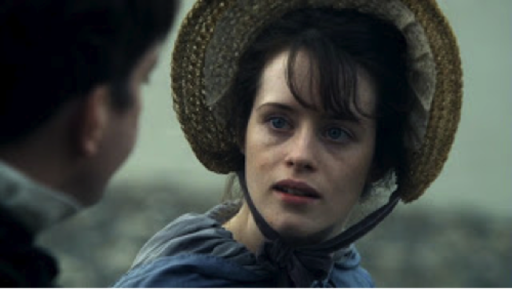
Amy Dorrit.
Amy Dorrit (Little Dorrit) may be one of the most selfless characters I’ve ever come across. Amy’s strength, perseverance, and honesty is almost too hard to watch at times, especially in the face of such hardship, but she’s a definite inspiration.
She’s pragmatic.

Lt. Abbie Mills.
“I’m not gonna say I believe you, but I’m the closest thing to it.”
Lt. Abbie Mills (Sleepy Hollow) is one no-nonsense individual, but she’s not completely closed-minded. The best female characters are practical yet always know when to branch out and embrace the crazy when the occasion calls for it.
She knows what she believes.
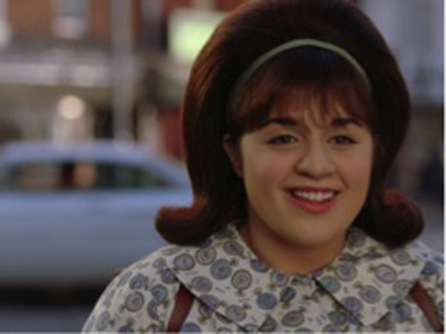
Tracy Turnblad.
Tracy Turnblad (Hairspray) isn’t afraid to be who she is, she’s proud of herself and her talents, and she stands up for what she believes in, even when those beliefs may cost her her dream. You can’t get more kick-butt than that.
She’s relentless.

Leslie Knope.
Have you *seen* the binders Leslie Knope (Parks and Recreation) churns out when she’s on a mission? Boy do I love her ambition and ability to Get. Stuff. Done. Sleep? Who needs it? Not when there’s work to do and glass ceilings to break.
She’s witty (and deliciously sarcastic).

Veronica Mars.
Veronica Mars is the Queen of the Comebacks. She’s the Comeback Kid. A One-Liner Superstar. If I had a dime for every time she successfully put someone in their place, I’d be one rich marshmallow. How many times have I wished I had her chutzpah? Let me count the ways…
She’s wicked smaht.

Hermione Granger.
A girl with a brain as big as her heart? Sign me up. Hermione Granger (Harry Potter) keeps her nose buried in books and wields the strongest weapon of all: knowledge.
She’s flawed but shows growth.
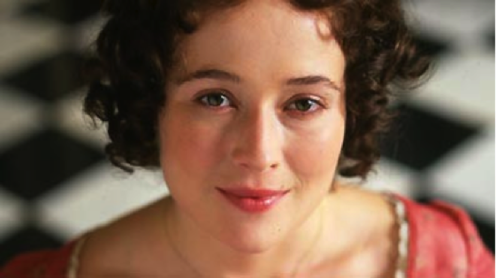
Elizabeth Bennet.
Elizabeth Bennet (Pride and Prejudice) is so delightfully self-righteous and snarky to Mr. Darcy that it makes it that much more delightful and satisfying when she admits she was wrong about him. I absolutely love character growth. The best heroines learn a thing or two along their journey.
She sticks it out, even when the going gets rough.
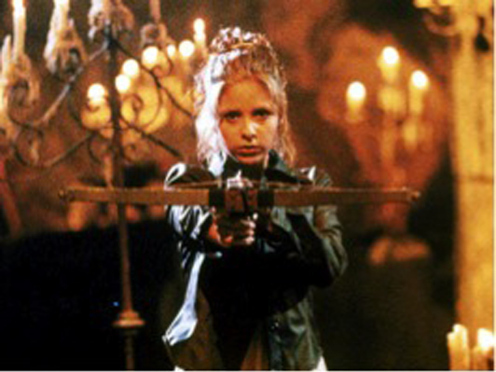
Buffy Summers.
Buffy’s destiny as the Vampire Slayer is a lonely road to walk, but someone’s gotta do it. A great heroine sacrifices a normal life — and sometimes happiness — to do what’s right (and save the world).
She’s brave, dangit.
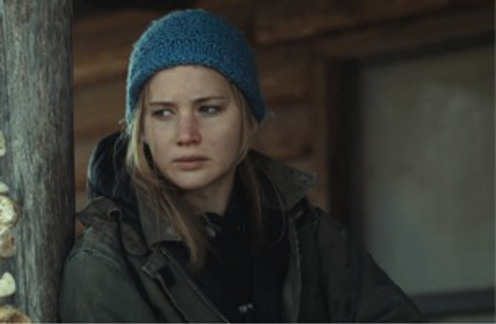
Ree Dolly.
Ree Dolly (Winter’s Bone) is forced to save her home and her family by facing down a meth crime boss and his cronies. Her journey is intense and gruesome, but she sticks it out no matter what might happen to her. Girl’s got BRAVE coming out of her ears.

MG Buehrlen
When she’s not writing, M.G. moonlights as a web designer and social media/creative director.
She’s the current web ninja lurking behind the hugely popular website YABooksCentral.com,
a social network for YA (and kids!) book lovers. The 57 Lives of Alex Wayfare is her debut novel. M.G. lives nestled away in Michigan pines, surrounded by good coffee and good books, with her husband and son and three furbabies. Say hello on Twitter, Facebook, and Tumblr.





March 2, 2014
International Women’s Week: Guest Post from Laurie Loewenstein: We Want to Work
When tightly shut doors suddenly sprang open in 1917, America’s working-class women rushed into high-paying jobs formerly closed to them — as skilled machine workers at munitions factories, aircraft engine assemblers, trolley conductors and locomotive dispatchers. America’s entry into World War I simultaneously produced a shortage of labor and increased demand for goods, particularly munitions.
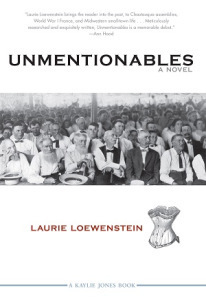
Akashic Books, 2014.
Women gladly walked away from the rows of sewing machines, the steaming commercial laundries, the textile mills, the paper box factories and their other monotonous, dangerous and low-paying positions.
But as quickly as these doors opened in 1917, they slammed shut in late 1919 when the war was over, the soldiers returned home and the women workers were no longer needed. Many were forced back into the traditional occupations of shop clerk, sewing machine operator, cook and laundress.
The period of 1917-1919 was a seminal moment for American women. They were stepping out of the social, economic, political and clothing restrictions of the Victorian era and pushing toward freedom of movement in all areas of their lives. That is why I set my novel, Unmentionable, during these turbulent years. The novel pivots on Marian Elliot Adams, an outspoken advocate of dress reform. Women’s suffrage, race relations and social inequality all come into play.
In recognition of International Women’s Day on March 8, I am focusing on the economic opportunities that opened to women during these two years. For working women, the chance to earn higher pay in skilled jobs was a golden opportunity.
In UNMENTIONABLES, 19-year-old Helen secures a job taking fares for a Chicago streetcar line. She is one of only a handful of women conductors in the city. The motormen and male conductors resent her presence and, within a matter of months, she is set up on a false charge of “knocking off” (stealing fares) and fired. This was not an unusual situation. Women were routinely harassed and discouraged from taking “men’s” jobs. However, many did not give up the better paying jobs and improved working conditions without a fight.
A report from the U.S. Department of Labor, Women’s Bureau in 1918 included first-hand comments by women trolley conductors, including this woman:
“(The) hours are irregular and I can pick the hours I want I found inspecting small parts in a factory very hard on my eyes and I found it so hard to attend to my duties at home For a long time while my children were small I had to do washing at home but it was so hard on my back I couldn’t stand it Why do I like this better Well I have lived through years of want and have not had sufficient food for my children so naturally I like being able to provide enough for them No one who has worked in a factory can fall to appreciate or understand why we prefer this outdoor work I tried driving a taxicab but found that too cold This is not work it’s being on duty without special exertion and being on duty under pleasant conditions with constant change of scenery always seeing people and interesting things Then the good wages have lifted my children out of the ranks of those in want I am supporting four and thank God my earnings now make It possible to give them the food clothing and shelter they need.”
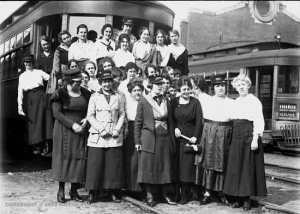
Women conductors. (Courtesy of the Library of Congress.)
A number of streetcar strikes, and threatened strikes, during 1918-1919 were called when women conductors were hired
Labor historian and teamster Bill Onish recounts:
“When Kansas City Railways initially hired thirty women conductors in March, 1918, the local union, following national practice at the time, threatened a strike, and then secured a ruling from a government board that there were still sufficient numbers of men available and women were unneeded. But after the June, 1918 draft call-up, when it became clear that a real labor shortage was developing, the union agreed to accept women conductors. This was in sharp contrast to the position taken by most other locals of the Amalgamated who bitterly, and often successfully, resisted female employment.
“When the company first announced their plans for hiring women they thought they might get by paying them only 36 dollar, a month—less than half what men received. Public protests forced them to modify this somewhat and the actual pay of the first women workers was 60 dollars a month—about 80 percent of the men’s scale. The union demanded equal pay and most of the women conductors became strong union supporters.”
By 1917, thousands of women could also be found on the shop floors of munitions and airplane plants. At the Remington Arms-Union Metallic Cartridge Co., women were hired to inspect and pack rifle shells and fill cartridges with powder. As the both the shortage of male workers and demand increased, the company began training the women for skilled positions, such as shell turners that required the shaping of a bulky munitions shells with a lathe. Almost universally, they worked less hours and were paid more than they had been in the female ghettos of the garment industry.
In the fledgling aircraft industry, women worked alongside men, assembling wing panels and fuselages. Seamstresses were hired to cover the wings with strips of linen, which were later varnished by other women workers.
When Armistice was declared on Nov. 11, 1919, more than a million women were working in factories that produced war materials or in secondary industries. Many were laid off within months and returned to the women’s trades. However, their example paved the way for women workers two decades later when women again answered the call, this time of World War II. It can also be argued the willingness of women to step up in 1917 to help the nation win the war contributed to the passage of the 19th Amendment, granting women’s suffrage.

Laurie Loewenstein.
Laurie Loewenstein is a fifth generation Midwesterner, and author of UNMENTIONABLES (Akashic Books, 2014). She has been a reporter, and a feature and obituary writer for several small daily newspapers as well as a college writing tutor. She was among the third class of women admitted to Colgate University. She has master degrees in history from Syracuse University and in creative writing from Wilkes University. She currently lives in Rochester, New York, where Susan B. Anthony lived and was arrested for voting in 1872. Visit her at laurieloewenstein.com. Follow her on Facebook or Twitter @lsloewenstein.





International Women’s Week: Guest Post from Tonya Bolden: Seeking Today’s Sarah
A few summers ago, I got an e-mail that made me go, Say, What?!
It was from a librarian I’ve known for years, Sherelle Harris of Norwalk, Connecticut. What she sent was a short post about Sarah Rector, a name that did not ring a bell. But the more I read—I was hooked!
Hooked on a real-life, yes-it-really-happened, rags-to-riches story.
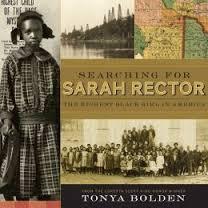
Abrams, January 2014.
Hooked on a life that took me into historical terrain largely trampled underfoot, obscured, buried. Historical truths such as the fact that some Native Americans were slaveholders. To those who argue that Indian slavery was benign, not “real” slavery, well, why, during the Civil War, did men like Sarah’s grandfathers join Union forces?
This is some of the territory I cover in SEARCHING FOR SARAH RECTOR: The Richest Black Girl in America. Of course I couldn’t tell Sarah’s story without recounting the Trail of Tears, which is how her forebears wound up in Indian Territory, a place that was to be a permanent homeland for Indians—and the people of African descent among them, enslaved and free–forced from their homelands in Alabama and elsewhere in the Southeast.
Indian Territory. One of many broken promises, one of many dashed dreams. Instead of it being a homeland for different Indian nations, in 1907 it became the 46th U.S. state: Oklahoma. Sarah Rector was five years old.
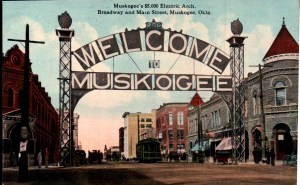
Postcard of Muskogee.
By then, vast expanses of land that Indian nations had held in common had been broken up into individual land allotments for members of those tribes—members Indian, members black, members mixed. The land young Sarah, living in Muskogee County, received was up in Creek County. Farming-wise the land was worthless. No one ever imagined that deep down under there flowed a whole lot of black gold.
Money so often brings out the worst in people and there was a lot of madness surrounding Sarah Rector’s riches. People were itching to get their grubby little hands on her money by hook or by crook. Newspapers said nasty things about this girl who was on her way to great wealth at the age of eleven. Newspapers also peddled wild and crazy stories about Sarah. Example: some reported that her mother was dead and that her father was in prison when Sarah’s parents were, in fact, right there with her in their home near the small town of Taft, Oklahoma.

Postcard of Glenn Pool, Oklahoma.
Compared to what befell scores of other oil-rich children during the Oklahoma-Texas oil boom, Sarah fared quite well. She was not robbed of her fortune. She was not murdered for her fortune. Sarah still had riches when she turned eighteen. By then, she and her family had moved to big, busy, bustling Kansas City, Missouri, the Paris of the Plains.
That’s where Sarah Rector lived until she died in the 1960s, not poor but not as wealthy as she might have been, as she could have been. It appears that she didn’t have solid financial advisers and likely had too strong a taste for the good life.
While working on SEARCHING FOR SARAH RECTOR, I sometimes wondered what might have happened to her riches had her family not moved to Kansas City. I mean no disrespect to K.C. and place no blame on her parents, but Sarah was a young woman when her family moved to that very jazzy city—-and this was during the Jazz Age. She wouldn’t have been the first small-town girl to have her head turned by the BIG CITY. Of course after the Jazz Age came the big, bad Great Depression. Many fortunes were lost.
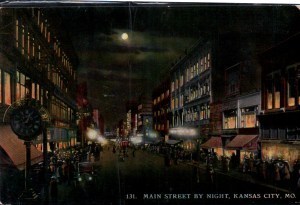
Postcard of Kansas City, Missouri.
And if young Sarah became oil-rich today? Surely the media would be more responsible and not run with every wicked rumor—but then again, with our 24/7 news, with our insta-this and insta-that, with our tweets and tumblers and flickers and our interest in the sensational and our constant celebrity watch, perhaps lies about Sarah and her riches would travel around the world twice—thrice even— before, as Churchill said, “truth has a chance to get its pants on.”
Would Sarah’s life be a Reality show today? Might she slap her name on a line of clothing, a perfume, a flashy pair of kicks? Would she hang with Paris Hilton?
I’d like to think that a 21st-century oil-rich girl (or boy) would get a college education which Sarah did not. Surely Sarah and her family would expect her to go to college, because college is more of social norm today, with some thinking it a birthright. Not so one hundred plus years ago. Very few Americans attended college. Most who did were young men because—well, you know why.
One of my highest hopes is that if there is a 21st-century Sarah Rector out there somewhere, she not only goes to college, but also majors in economics, then heads to Harvard Business School. Or Wharton. After all of that, surely she would have no problem managing her money, no problem steering clear of a Bernie Madoff.
Then again . . .
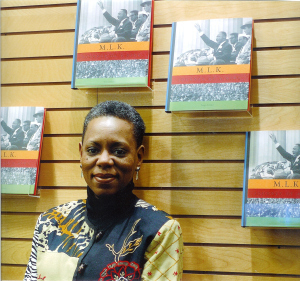
Tonya Bolden.
Tonya Bolden has written more than twenty books for children and adults. Born, bred and currently residing in New York City, she earned a B.A. (magna cum laude) from Princeton in 1981, and an M.A. in Slavic Languages and Literatures from Columbia University in 1985.
Tonya Bolden’s book include MARITCHA: A Nineteenth-Century American Girl, winner of the 2006 James Madison Book Award and a Coretta Scott King Honor book; M.L.K.: Journey of a King, winner of the 2008 Orbis Pictus Award for Outstanding Nonfiction for Children, and EMANCIPATION PROCLAMATION: Lincoln and the Dawn of Liberty, a Booklist Editor’s Choice for 2013, a 2014 ASLC Notable Children’s Book, and a 2014 NCSS Notable Social Studies Trade Book for Young People. On a somewhat lighter note, there’s Bolden’s 33 THINGS EVERY GIRL SHOULD KNOW and her “sister” 33 THINGS EVERY GIRL SHOULD KNOW ABOUT WOMEN’S HISTORY. SEARCHING FOR SARAH RECTOR: The Richest Black Girl in America is Bolden’s latest.
Bolden’s pastimes include gardening and watching BBC movies and series.





International Women’s Week: Guest Post from Tonya Bolden: Seeking today’s Sarah
A few summers ago, I got an e-mail that made me go, Say, What?!
It was from a librarian I’ve known for years, Sherelle Harris of Norwalk, Connecticut. What she sent was a short post about Sarah Rector, a name that did not ring a bell. But the more I read—I was hooked!
Hooked on a real-life, yes-it-really-happened, rags-to-riches story.

Abrams, 2014.
Hooked on a life that took me into historical terrain largely trampled underfoot, obscured, buried. Historical truths such as the fact that some Native Americans were slaveholders. To those who argue that Indian slavery was benign, not “real” slavery, well, why, during the Civil War, did men like Sarah’s grandfathers join Union forces?
This is some of the territory I cover in SEARCHING FOR SARAH RECTOR: The Richest Black Girl in America. Of course I couldn’t tell Sarah’s story without recounting the Trail of Tears, which is how her forebears wound up in Indian Territory, a place that was to be a permanent homeland for Indians—and the people of African descent among them, enslaved and free–forced from their homelands in Alabama and elsewhere in the Southeast.
Indian Territory. One of many broken promises, one of many dashed dreams. Instead of it being a homeland for different Indian nations, in 1907 it became the 46th U.S. state: Oklahoma. Sarah Rector was five years old.

Postcard of Muskogee.
By then, vast expanses of land that Indian nations had held in common had been broken up into individual land allotments for members of those tribes—members Indian, members black, members mixed. The land young Sarah, living in Muskogee County, received was up in Creek County. Farming-wise the land was worthless. No one ever imagined that deep down under there flowed a whole lot of black gold.
Money so often brings out the worst in people and there was a lot of madness surrounding Sarah Rector’s riches. People were itching to get their grubby little hands on her money by hook or by crook. Newspapers said nasty things about this girl who was on her way to great wealth at the age of eleven. Newspapers also peddled wild and crazy stories about Sarah. Example: some reported that her mother was dead and that her father was in prison when Sarah’s parents were, in fact, right there with her in their home near the small town of Taft, Oklahoma.

Postcard of Glenn Pool, Oklahoma.
Compared to what befell scores of other oil-rich children during the Oklahoma-Texas oil boom, Sarah fared quite well. She was not robbed of her fortune. She was not murdered for her fortune. Sarah still had riches when she turned eighteen. By then, she and her family had moved to big, busy, bustling Kansas City, Missouri, the Paris of the Plains.
That’s where Sarah Rector lived until she died in the 1960s, not poor but not as wealthy as she might have been, as she could have been. It appears that she didn’t have solid financial advisers and likely had too strong a taste for the good life.
While working on SEARCHING FOR SARAH RECTOR, I sometimes wondered what might have happened to her riches had her family not moved to Kansas City. I mean no disrespect to K.C. and place no blame on her parents, but Sarah was a young woman when her family moved to that very jazzy city—-and this was during the Jazz Age. She wouldn’t have been the first small-town girl to have her head turned by the BIG CITY. Of course after the Jazz Age came the big, bad Great Depression. Many fortunes were lost.

Postcard of Kansas City, Missouri.
And if young Sarah became oil-rich today? Surely the media would be more responsible and not run with every wicked rumor—but then again, with our 24/7 news, with our insta-this and insta-that, with our tweets and tumblers and flickers and our interest in the sensational and our constant celebrity watch, perhaps lies about Sarah and her riches would travel around the world twice—thrice even— before, as Churchill said, “truth has a chance to get its pants on.”
Would Sarah’s life be a Reality show today? Might she slap her name on a line of clothing, a perfume, a flashy pair of kicks? Would she hang with Paris Hilton?
I’d like to think that a 21st-century oil-rich girl (or boy) would get a college education which Sarah did not. Surely Sarah and her family would expect her to go to college, because college is more of social norm today, with some thinking it a birthright. Not so one hundred plus years ago. Very few Americans attended college. Most who did were young men because—well, you know why.
One of my highest hopes is that if there is a 21st-century Sarah Rector out there somewhere, she not only goes to college, but also majors in economics, then heads to Harvard Business School. Or Wharton. After all of that, surely she would have no problem managing her money, no problem steering clear of a Bernie Madoff.
Then again . . .

Tonya Bolden.
Tonya Bolden has written more than twenty books for children and adults. Born, bred and currently residing in New York City, she earned a B.A. (magna cum laude) from Princeton in 1981, and an M.A. in Slavic Languages and Literatures from Columbia University in 1985.
Tonya Bolden’s book include MARITCHA: A Nineteenth-Century American Girl, winner of the 2006 James Madison Book Award and a Coretta Scott King Honor book; M.L.K.: Journey of a King, winner of the 2008 Orbis Pictus Award for Outstanding Nonfiction for Children, and EMANCIPATION PROCLAMATION: Lincoln and the Dawn of Liberty, a Booklist Editor’s Choice for 2013, a 2014 ASLC Notable Children’s Book, and a 2014 NCSS Notable Social Studies Trade Book for Young People. On a somewhat lighter note, there’s Bolden’s 33 THINGS EVERY GIRL SHOULD KNOW and her “sister” 33 THINGS EVERY GIRL SHOULD KNOW ABOUT WOMEN’S HISTORY. SEARCHING FOR SARAH RECTOR: The Richest Black Girl in America is Bolden’s latest.
Bolden’s pastimes include gardening and watching BBC movies and series.





March 1, 2014
International Women’s Week: Guest Post from AC Gaughen: It’s a Girl Thing
When I was 9 years old, I knew I wanted to be a writer. I have this old piece of paper where I declare that simply because I say I’m a writer, I AM.
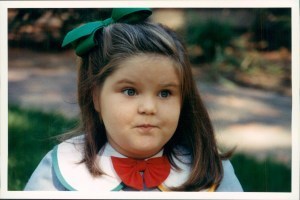
Nine-year-old AC!
Cute, yes. Realistic—well, yes and no. The Kid Me did not know about what writing—the craft of it, separate from the publishing of it—was really all about. She didn’t know how difficult it would be, how long it would take. What the Kid Me had absolutely nailed down, however, was how important it is to believe in yourself—and looking back, I see how easy it was to do then.
Believing in myself has become anything but easy since.
I blame many different things. Certainly, when it comes to writing, publishing is a rigorous process that strips you to the bone. It took years of rejections—some so close to the Almighty YES that they were that much more agonizing—to get an agent. When I got a publishing deal, I was so convinced it was going to somehow fall through or be taken away from me, because that’s what I had been conditioned to believe. Every rejection, every almost yes, shook my faith in myself.
And yet, there was something incredibly legitimizing about having the book deal. I felt like, for once, for however short a time it might last, I had the right to call myself a writer. To give myself that label the Kid Me so easily claimed.
It’s no coincidence, then, that it was about a month after my book deal was finalized that I was talking to a friend, talking about her newly formed non-profit with barely any programming, and talking, at the same time, about how teen girls don’t have enough people believing in them—pushing them—backing them.
That conversation turned into the Girls’ Leadership program of Boston GLOW (Girls’ Leadership and Organized Women, bostonglow.org), of which I’m currently the director. We created the IGNITE Change Leadership Contest that day, and invited girls to submit plans for local, actionable change for women and girls in their community.
That first year, we received eight submissions. Eight! We were giving away a solid amount of money, too—I think our first year we offered a $1000 scholarship to the winner and something like $5000 total to the top ten finalists—and we only got eight.
We went back to the teachers and program coordinators who helped distribute the information, and asked them what had happened. From multiple sources we heard a disturbing sentiment: “The girls said, ‘I’ll never win that. Why should I apply?’”
Obviously, this is messed up—for me as a program director, I wanted to shout that we literally had more checks than finalists. I’ve spent the years since scaffolding engagement to make girls feel supported, and encouraged, and somehow reversing this damning idea.

Young AC on a boating adventure.
But I think about this all the time. I think about what GLOW can do as an organization to change it. Then I think about how women have to be asked an average of six times to run for office, and men never have to be asked. I think about how my college advisor told me I shouldn’t write because I’d never make money. I thought about how, when asked what I do for a living, I used to tell people first about the awful, part time retail job I used to have, and then the hotel job I used to have—even now, I say I’m a grad student, and I mention the writing later, if at all.
LADY THIEF is sitting beside me on the desk as I write this. It’s under a lamp, so there’s an atmospheric highlighting over Scarlet’s captivating face. She’s got her knife in her hand, and frankly, I think she’s mad at me.
Because SCARLET wasn’t a book that I was inspired to write—it was a book and a character I had to write. Somewhere deep inside me I wasn’t content to let other people take my dreams away from me.
I wasn’t content to have my desires and hopes belittled.
I wasn’t content to listen to my own language change to accommodate the lack of respect other people had for my ambitions.
And I used to think that it was the writing thing—writing is an unlikely career, and God no, I don’t make enough money to support myself by writing alone.
But then I started working with these teen girls. It’s not that they don’t have ideas—they have the most amazing ideas. There are girls who are convinced that teaching yoga will create new female support systems, that painting a mural in Chinatown will help women travel beyond its limiting borders, and that having a multicultural book drive—where the girl could, for once, see herself on the cover—might change the ambitions women have to be a part of literature. These girls have the most stunning voices I’ve ever heard.
But they are also systematically convinced that their voices don’t matter. That their dreams don’t count. That their hopes should be decided and approved by someone else.
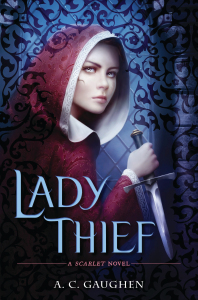
Walker Childrens, February 2014.
It’s not a writer thing. It’s a girl thing. It’s a woman thing.
I wrote SCARLET because I will never agree with this. Even if I have to do it through her grumpy wit and her (rather impressive) skills with a knife, I will always fight for my dreams to be respected. Mostly because I believe that my actions will always affect the lives of those around me, and I want to live my dream so that other women, maybe, just a tiny bit, can feel a little hint of permission to do the same.
Every year, we get more beautiful voices joining in our IGNITE Change Leadership Contest. Every year, I’m reminded of all those that are still out there, still silent, still holding their breath and looking around them and waiting for someone else to speak first. I feel so keenly what it’s like to be that girl.
What was my inspiration to write SCARLET and LADY THIEF? It was a 9 year old girl who proclaimed that she was a writer. It was a 14 year old girl who had gone silent. And it was a 25 year old girl who was trying to figure out what she could do to ignite change.

AC Gaughen.
A. C. Gaughen is the author of Scarlet. She serves as the Director of Girls’ Leadership for Boston GLOW, a non-profit organization that creates opportunities to encourage and engage teen girls in the greater Boston area. She holds a masters degree in Creative Writing from St. Andrews University in Scotland and currently lives in Boston, Massachusetts, where she is pursuing her Masters in Education from Harvard University.





International Women’s Week: Guest Post from Sheila Barry: Where Barbie Can’t Go
As I write this post, Barbie™ is gracing the cover of the Sports Illustrated swimsuit issue. I initially thought that this was a brilliant subversive gesture designed to put paid once and for all to the question of whether the swimsuit issue dehumanizes women. I now gather I was wrong. Because on her blog (and like you, I did not know until today that she has a blog), Barbie defends the right of girls to be whatever they want to be. Including swimsuit models. This is where fifty years of second-wave feminism has taken us.
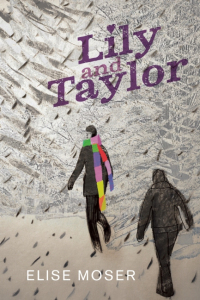
Groundwood Books, September 2014.
It’s possible that Barbie is just too big to oppose. I certainly wanted a Barbie doll desperately as a child, to the chagrin of my sex-averse mother. I also desperately wanted to eat at McDonald’s and have real Levi’s jeans with a tag. I wanted these things because the genius of capitalism is to create a desire (to be beautiful, to have fun, to have people looking admiringly at the tag on my butt) and then persuade us that only one product on earth can fulfill that desire. Like the rest of us, little girls are taught that happiness is found in objects. And when the objects are Barbie dolls, little girls learn to accept objectification as part of the whole sparkly package.
When I’m not compiling lists of all the wonderful consumer goods that I longed for and never received as a child (hello, Easy-Bake Oven), I publish books for children and young adults at Groundwood Books. Some of these books offer pure delight. But many of Groundwood’s titles take a more serious look at the world we live in. One book, Elise Moser’s remarkable novel LILY AND TAYLOR, is a story about relationship abuse, about the vulnerability of a girl who believes that to be loved is to be treated as an object—sometimes an object of affection, but just as often an object of violence. It’s a difficult book to read, although every teenage girl I know who read it said she couldn’t put it down.
On International Women’s Day, I would like to imagine every girl holding a book that she just can’t put down, a book that speaks directly to her own lived experience and that also suggests multiple possibilities for the future. I would like to imagine every girl knowing that Barbie isn’t a real person, no matter how many blog posts she writes, no matter how many magazine covers she adorns. But every girl is a real person, and with very book we publish, Groundwood Books tries to recognize and celebrate that fact.

Sheila Barry.
Sheila Barry is the publisher of Canada’s celebrated independent children’s book press, Groundwood Books. She has worked in the industry for twenty years, spending eight years as the editor-in-chief at Kids Can Press, and formerly serving as the president of the Canadian Children’s Book Centre. She lives in Toronto, Canada, and can be found on Twitter @SheilaB27.





February 25, 2014
Good News! A JAB OF DEEP URGENCY: FOUND POEMS to be published by Finishing Line Press
Hi Everyone!
I can barely contain myself as I type out this exciting news, just in time for my trek up to Seattle for my very first AWP conference. (Squee! More on that later.)
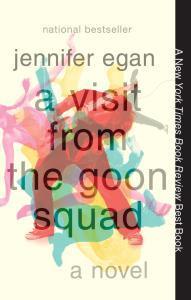
Anchor, Paperback Edition, March 2011.
So back in April of 2013, I participated in one of the most exciting and exhausting and challenging and rewarding National Poetry Month events ever: Found Poetry Review‘s Pulitzer Remix. Using Jennifer Egan‘s A VISIT FROM THE GOON SQUAD as source text, I created 30 erasure poems, which I later compiled into a chapbook entitled A JAB OF DEEP URGENCY. I sent this chapbook off into the world last fall and over the winter, thinking maybe, just maybe, someone would give it a home. I knew it was weird and different, but, hey, I’d seen a few of my remixer friends publish their found poems in chapbooks and I thought maybe I should try doing the same. Maybe. It was a very big maybe.
And then this:
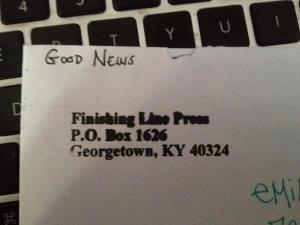
GOOD NEWS!!!
Which I shared on Facebook and Twitter last week. The photo, but not the details. Here are the details. (Huzzah!) This was the snail-mail follow up to an email I received not too long ago, saying that Finishing Line Press, a chapbook publisher that I LOVE, wanted to publish A JAB OF DEEP URGENCY. Holy crap, right? I knew that this chapbook was pushing a few envelopes. And I was clinging to the fact that precedent existed, to the fact that I thought my poems were, well, pretty good. And that sometimes you just really need good news.
GOOD NEWS CAME.
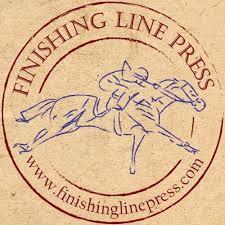 And I finally get to tell you about it! That is kind of the best part. Other than the my-chapbook-is-being-published part.
And I finally get to tell you about it! That is kind of the best part. Other than the my-chapbook-is-being-published part.
So…what is a chapbook? Most of y’all who read my blog might not have heard of a chapbook. That’s okay. I hadn’t either until I’d been publishing poetry in magazines for a few years. A chapbook is like a mini-collection of poetry, often centered on a theme, and containing between 15-30ish pages of poetry, depending on the author and publisher. It’s usually printed in a limited run, and sometimes even hand-bound. Still curious? The Wikipedia article on chapbooks is actually pretty great.
So…CHAPBOOK! A JAB OF DEEP URGENCY! COMING OUT! FROM FINISHING LINE PRESS! It’s still too soon to pre-order or have a cover (though I have a fab artist for the cover and I am SO EXCITED) or any of that, but Finishing Line will be sending out a bunch of postcards to announce pre-order things and release date details. IF YOU WOULD LIKE A POSTCARD, email e.kristin.andersonATgmailDOTcom with your mailing address. We’ll make sure you get one!
Meanwhile, I’ll be doing my happy dance. All the way to AWP, in Seattle, where hopefully I will see some of y’all! This conference will really be feeding the poetical/adult literary side of my writing life, and I’m very excited for that. But I’m also thrilled to hear that there will be kidlit folks there as well. Huzzah! I’m presenting on a panel with Found Poetry Review editors and Pulitzer Remix participants on organizing projects on the internet and gaining publicity for your organization. If you’ll be at AWP, be sure to come check us out on Thursday morning: R112 Project-Driven Publicity for Publishers and Writers. We’ll also be hosting a reading on Friday evening. Check out the Facebook Page for the Pulitzer Remix/er, and join us!
The Remix/er is open to the public, so even if you won’t be attending AWP, you’re welcome to attend. This is actually my first “real” poetry reading. I’m nervous and excited, and, incidentally, I’ll be reading selections from my forthcoming chapbook. See? It comes full circle.
Have a great week, y’all. Here’s hoping everyone gets some good news in their mailboxes soon!





February 5, 2014
Review: ALL THE TRUTH THAT’S IN ME by Julie Berry
This is a dark book. ALL THE TRUTH THAT’S IN ME follows the story of a girl who has lost her ability to speak in one of the most horrible ways imaginable. And, perhaps the worst part, is that she has returned to a town that fears her. A family that rejects her. And a former best friend, a friend she loves, whom she doesn’t quite know how to reach out to.
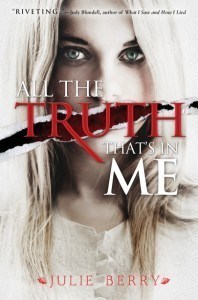
Viking Juvenile, September 2013.
Taking place in a colonial-esque village, Julie Berry’s latest is not for the feint of heart. After being kidnapped and maimed, Judith has pretty much accepted her fate as an outcast. But there are problems. There’s the fact that the other girl who went missing died, and the town has questions she can’t — or maybe can’t bring herself — to answer. Her mother has told her not to even try to speak, because the sounds she makes are too monstrous. And Judith can’t quell her love for the boy who she knows can’t love her as she is now. When an attack on her town threatens to destroy the lives of everyone she loves, Judith knows what she has to do. But it won’t be easy. And, in the end, it might not only open old wounds but create new questions that she cannot answer.
ALL THE TRUTH THAT’S IN ME is frightening. Not just because of the horror, but because of the reality that Judith’s story could be anyone’s. That this isn’t a phenomenon of any specific time period. It is frightening because Judith is a hero who doesn’t know her own power, who is easily written off as weak or tragic or freakish. And it is frightening because Julie Berry has written it so beautifully, sparing no detail, leaving nothing out that might reveal the truth of the human heart. This book has already received some fantastic accolades. I hope to see many more.





February 3, 2014
Review: CRACKED by Eliza Crewe
I love a novel narrated by the bad guy. And that’s what Meda is — she’s the bad guy. She’s not really sure what kind of bad guy she is, but she knows that if it wasn’t for her love for her mother, she’d be way badder. She eats souls. And she’s doing her best to keep her menu limited to souls that deserve it. But everything changes on the night she mets Chi and his Templar friends.
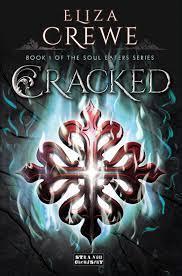
Strange Chemistry, November 2013.
The Templar are an order of men and women dedicated to one thing — taking out demons. And it seems like they might have answers to all of Meda’s questions — what she is, where she comes from, who her father might have been. And if she can convince her new pals that she needs their protection, maybe those answers can be hers. Of course, plans don’t really pan out, and it’s not long before Meda, Chi, and crew are in way over their heads.
CRACKED is a fast and furious action novel, narrated by a snarky delinquent that readers are sure to get a kick out of. With a little bit of Catholic mythology and a dash of conspiracy theory, Eliza Crewe has whipped up a debut that, even without vampires, is sure to make fans of authors like Richelle Mead and Lili St. Crow salivate for the next book in this exciting series.





January 31, 2014
Review: ENGINES OF THE BROKEN WORLD by Jason Vanhee
Let me start by saying: This is one of the spookiest books I’ve read in quite a while. There’s so much going on in this story, and it’s pretty freaking bizarre, so I’m going to give you a list of the six most awesome freaky spooky things that you’ll find in Jason Vanhee‘s ENGINES OF THE BROKEN WORLD:
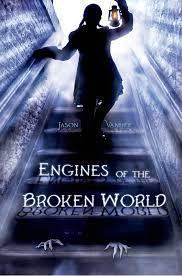
Henry Holt and Company (BYR), November 2013.
1. Dead mom. No, wait. Dead mom’s body hanging out under the kitchen table, because she’s too hard for the kids to move.
2. The kids — Merciful Truth and her older brother Gospel — can’t get anyone to help move her because there is no one. On account of the end of the world. On account of the world is closing in on everyone.
3. The only people left are crazy and/or too old to be of much help outside of stories. And some of them are losing body parts to the end of the world thing.
4. The Minister. It’s a cat. Or is it a dog? Or a squirrel? Or is it anything?
5. Dead mom. Again. Only, maybe not dead. Or is she?
6. The cellar.
This is a book that will consume you. It will chill you to your bones, even if you’re not reading it in one of those northern areas where it actually snows. This is not an end-of-the-world book. It’s psychological horror. And it will leave you full of questions. In a good way. Jason Vanhee is absolutely an author to watch.










